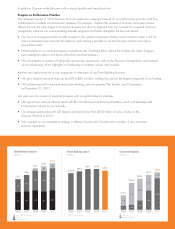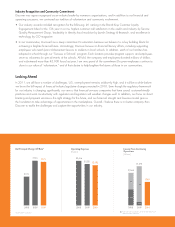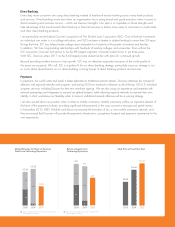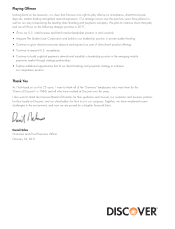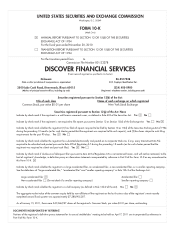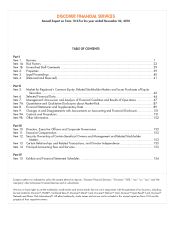Discover 2010 Annual Report Download - page 16
Download and view the complete annual report
Please find page 16 of the 2010 Discover annual report below. You can navigate through the pages in the report by either clicking on the pages listed below, or by using the keyword search tool below to find specific information within the annual report.Credit Risk Management
Credit risk management is a critical component of our management and growth strategy. Credit risk refers to the risk of
loss arising from borrower default when borrowers are unable or unwilling to meet their financial obligations to us. Our
credit risk is generally highly diversified across millions of accounts without significant individual exposures. We manage
risk according to customer segments and product types, among other things. See “– Risk Management” for more
information regarding how we define and manage credit and other risks.
Account Acquisition (New Customers)
We acquire new credit card customers through our marketing efforts, including direct mail, internet, print advertising,
telemarketing and merchant relationships, or through unsolicited individual applications. We also use targeted marketing
efforts to prospective student loan and personal loan customers, although student loan customers may also submit
unsolicited individual applications. In all cases, we have a rigorous process for screening applicants.
To identify credit-worthy prospective customers, our credit risk management team uses proprietary targeting and
analytical models and our marketing team matches them with our product offerings. We give consideration to the
prospective customer’s financial stability, as well as ability and willingness to pay. In order to make the best use of our
resources used to acquire new accounts, we seek out production efficiencies, conduct creative testing and aim to
continuously improve our product offerings and enhance our targeting and analytical models.
We assess the creditworthiness of each credit card, student loan and personal loan applicant through our underwriting
process. We evaluate prospective customers’ applications using credit information provided by the credit bureaus and
other sources. We use credit scoring systems, both externally developed and proprietary, to evaluate customer and credit
bureau data. When appropriate, we also use experienced credit underwriters to supplement our automated decision-
making processes.
Upon approval of a customer’s application, we assign a specific annual percentage rate (“APR”) using an analytical
pricing strategy that provides competitive pricing for customers and seeks to maximize revenue on a risk-adjusted basis.
For our credit card loans, we also assign a revolving credit line based on risk level and income.
Credit Card Portfolio Management (Existing Customers)
Unlike our installment loan products, which are billed according to an amortization schedule that is fixed at the time of
the disbursement of the loan, the revolving nature of our credit card loans requires that we regularly assess the credit risk
exposure of our customers’ accounts. This assessment reflects information relating to the performance of the individual’s
Discover account as well as information from credit bureaus relating to the customer’s broader credit performance. We
utilize scoring models (statistical evaluation models) to support the measurement and management of credit risk. At the
individual customer level, we use custom risk models together with generic industry models as an integral part of the
credit decision-making process. Depending on the duration of the customer’s account, risk profile and other performance
metrics, the account may be subject to a range of account management treatments, including limits on transaction
authorization and increases or decreases in purchase and cash credit limits.
Customer Assistance
We provide our customers with a variety of tools to proactively manage their accounts, including a website dedicated
to customer education and payment reminders through email and mobile text alerts. These tools are designed to limit a
customer’s risk of becoming delinquent. However, once a customer’s account becomes delinquent or is at risk of
becoming delinquent, we employ a variety of strategies to assist customers in becoming current on their accounts.
All monthly billing statements of accounts with past due amounts include a request for payment of such amounts. After
the first monthly statement that reflects a past due amount, these accounts also receive a written notice of late fee charges
as well as an additional request for payment. Customer assistance personnel generally initiate contact with customers
within 30 days after any portion of their balance becomes past due. The nature and the timing of the initial contact,
typically a personal call or letter, are determined by a review of the customer’s prior account activity and payment habits.
We reevaluate our collection efforts and consider the implementation of other techniques, including internal collection
activities and use of external vendors, as a customer becomes increasingly delinquent. We limit our exposure to
-5-


